 |
Scriptures For Bolivians
by Larry Clark
From “In Other Words,” October/November 1985
The Summer Institute of Linguistics in Bolivia has translated the New Testament into thirteen indigenous languages and prepared Scripture portions for several others. The translation work of SIL in seven language families is described here. Each group within a language family is a distinct language not understood by neighboring groups.
TUPI-GUARANI This language family numbers over 26,000 in Bolivia and four language groups of them have the New Testament. They dwell in lowland areas of eastern Bolivia.
Some of the Eastern Guarani came to Christ before any Scriptures were available and most of the preaching was in Spanish. The Guarani understood little of the messages and dozed through many services. Finally in 1977, when Scriptures in their own language were read in church, they exclaimed, “We have never heard anything like this before! This we can understand. This is what we need. Thank you.”
About 150 Western Guarani people gathered this year and filled a ranch chapel to witness the presentation of the New Testament. All adult readers who attended purchased a copy. Two young men who bought copies sat down and prayed together. They thanked God for the Word in their own language.
Once roving forest-dwellers, the Sirionó killed game with eight-foot bows. Now there is new hope for the nomads of the long bow. Two hundred Sirionó people gathered in September, 1977, to hear translation helper Chiro say, “This Lord’s Day we dedicate to God the New Testament in our very own language. God’s Word coming to us is like God taking us by the arm and saying, ‘This is My way; walk in it.’ God guides us by means of His Word. When we fall, He helps us up.” The Word of God in Sirionó is undergirding believers and producing a strong church.
The Guarayu church is small but growing. Ten years ago a farm laborer named Marcelo trusted in the Lord. He trained as a bilingual teacher and became a deacon in the church. As he worked on the Guarayu Scriptures he grew in the Lord and, strengthened by the Word in his own tongue, became the lay pastor of a congregation of believers. Marcelo serves with little pay and works in the fields to support his family. But as co-translator of the New Testament, he understands the power of the Word to penetrate the lives of a people who are resisting the Gospel message. The Lord of the harvest is calling the Guarayu people to be His own. The New Testament, published this year, is ready for distribution. It is life-giving seed for the Guarayu church. |
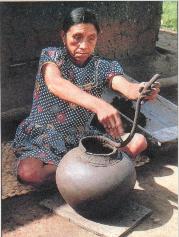
|
|
A Guarayu woman molds strips of damp river mud into a clay pot. |
TACANAN Four Indian groups in the Tacanan language family live near various rivers in the northernmost reaches of Bolivia. Though they number a little over 5,000, they have received the same care as larger groups.
Julio Marupa and Lucio Beyuma volunteered to help with Tacana New Testament. For Lucio it meant leaving his home and his fields and facing the persecution of other villagers. He stuck it out and completed the translation. Both Lucio and Julio have continued to live and work for the Lord. We thank God for men like this who were willing to sacrifice to bring the Word of God to their own people. The New Testament was presented in 1981.
The Ese Ejja group also needed the Word. Long ago the Sonene clan tried to exterminate the Big River clan. They crept up to the Big River camp and with a loud shout began to butcher every person they found. Why? Out of fear of the evil spirits they thought the Big River clan might control. Now the “river gypsies” of northern Bolivia have the New Testament, published in 1984, and killings are part of a dark past. A growing church is using the Word and the Ese Ejjas are being changed by the power of God.
The Cavineña New Testament was printed this year! The translators praise the Lord and thank all who have prayed to make it possible. Long months of revising the manuscript, keyboarding the changes and reading the manuscript and proofreading are over. Believers meet to study the Scriptures and all the Cavineñas may now listen to the Word as it is broadcast in their own language over the airwaves.
When first contacted, the Araona people were a nomadic, hunting and gathering society, with little knowledge of a Supreme Being or of the Word of God, and none of them could read or write. The tiny group of 39 was in danger of dying out. Translators labored 20 years among the Araona, who now have Old and New Testament Bible portions in their own language. Their number has increased to 64 and various ones have made profession of faith in the Lord and are open to the Word.
ARAWAKAN Three Arawakan languages with some 10,000 speakers are in north central Bolivia. New Tribes Mission translated the New Testament into the Trinitario language. SIL prepared Scripture portions for the Baure and translated the Ignaciano New Testament.
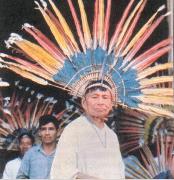
|
The peaceloving Ignacianos, with three centuries of Christian influence, have many colorful and interesting traditions. But very few know Christ in a personal way. Over the years the translators have gained the confidence of the people and some Ignacianos have come to the Lord. The complete New Testament, published in 1980, is now available in the scattered communities where the 4,000 Ignacianos live. |
Ignacianos celebrate Christmas with macaw-feather headdresses and dancing. |
|
PANOAN A surprising number of Panoan languages are now extinct and the Chacobo people, a semi-nomadic group of hunters and food gatherers, had dwindled to 135 people by 1955 when first contacted by SIL. After ten year’s work among the Chacobo, not one person had yet believed the Gospel News. One evening the translator started singing a hymn. Soon he was surrounded by men who wanted to sing and have a meeting. Afterwards, Caco stayed behind and said, “I want to follow Christ.” He left, his face beaming, “a new creature in Christ.” Today, a growing number of believers in this tiny group of 300 people have the New Testament, published in 1979. |
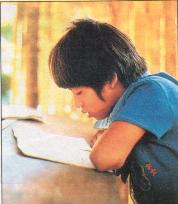
|
|
Chacobo children can now attend school in their own language. |
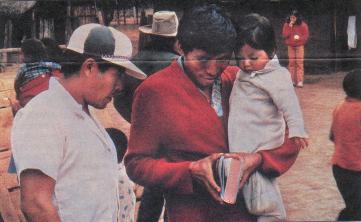
Chiquitano Christians have taken over the responsibility of distributing their completed New Testament. |
CHIQUITANO The Chiquitano language is probably not related to any other group and is spoken by 20,000 people in lowland regions near the borders of Brazil and Paraguay. Isabel slipped over to her wooden trunk and carefully lifted out the folder with the homework. Sitting down next to the literacy worker, she began to read slowly one word after another. She is on the road to becoming literate, leaving behind many years of ignorance and shame. One day Isabel will open the New Testament and read it for herself. This is her burning desire since she opened her heart to the Lord. Meanwhile, she can now hear on the radio the Chiquitano Scriptures, published in 1980, because they are now broadcast in her own language. |
QUECHUAN In vivid contrast to the lowland groups, the Quechua nation numbers over 1,500,000 speakers in Bolivia alone and are kin to the ancient Incas.
Quechua people trudge over wind-swept trails, knitted caps pulled down over their ears. They live in isolated villages hidden away among the mountain ranges of the Andes. Those who can’t or won’t read may now hear the Word on their battery-powered radios as Martin Chiri, a brilliant Quechua with a resonant voice, broadcasts readings from the New Testament, published in 1977.
Centuries ago thousands of runners spent their lives carrying messages throughout the vast Inca empire. They had to deliver the news. Today, Bible translators are bringing the Good News of the Gospel to another Quechuan group in the northern highlands. Now the Northern Bolivia Quechuas, who number close to 120,000, are receiving a message they can understand. Their New Testament will be published this year.
|
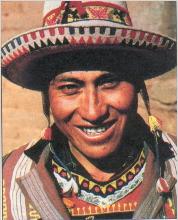
A Quechua’s exuberant embroidery and smile demonstrate the vitality of his culture. |
MACRO-MAYAN Rather than bow under Spanish conquerors, the Chipayas migrated to the harsh altiplano, a dusty desert area at 12,000 feet where crops were hard to grow. They desired freedom but instead found themselves at the mercy of floods, drought, sickness and death. And they were slaves to the spirits that dominated them. Now a thriving church exists among the 1,000 Chipaya and many of them are finding new freedom by following the Lord. They are free from fear to serve a powerful and loving God. Their New Testament was published in 1978.

|
Bolivia is a landlocked country approximately 1/7 the size of the United States. It has a rich heritage of indigenous peoples and languages. Most of the language groups in which SIL has worked are shown in bold face on this map. The first New Testament published in Bolivia, the Eastern Guarani, was a joint venture of the International Bible Society and the World Home Bible League. Special thanks is given to the World Home Bible League for publishing the rest of the SIL New Testaments in the languages of Bolivia’s indigenous people, as well as numerous Scripture portions. |
|